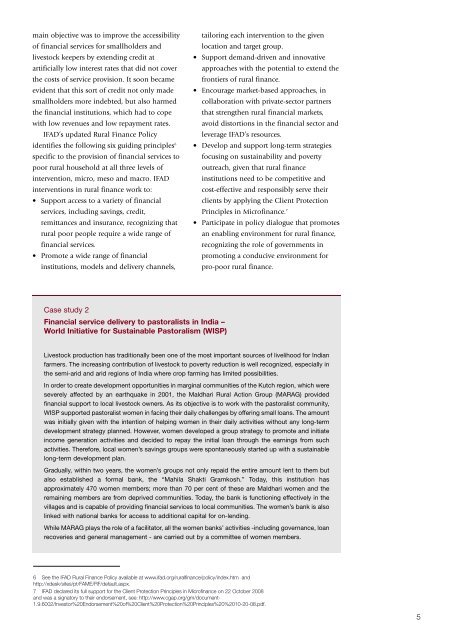Livestock and rural finance - IFAD
Livestock and rural finance - IFAD
Livestock and rural finance - IFAD
You also want an ePaper? Increase the reach of your titles
YUMPU automatically turns print PDFs into web optimized ePapers that Google loves.
main objective was to improve the accessibility<br />
of financial services for smallholders <strong>and</strong><br />
livestock keepers by extending credit at<br />
artificially low interest rates that did not cover<br />
the costs of service provision. It soon became<br />
evident that this sort of credit not only made<br />
smallholders more indebted, but also harmed<br />
the financial institutions, which had to cope<br />
with low revenues <strong>and</strong> low repayment rates.<br />
<strong>IFAD</strong>’s updated Rural Finance Policy<br />
identifies the following six guiding principles 6<br />
specific to the provision of financial services to<br />
poor <strong>rural</strong> household at all three levels of<br />
intervention, micro, meso <strong>and</strong> macro. <strong>IFAD</strong><br />
interventions in <strong>rural</strong> <strong>finance</strong> work to:<br />
• Support access to a variety of financial<br />
services, including savings, credit,<br />
remittances <strong>and</strong> insurance, recognizing that<br />
<strong>rural</strong> poor people require a wide range of<br />
financial services.<br />
• Promote a wide range of financial<br />
institutions, models <strong>and</strong> delivery channels,<br />
tailoring each intervention to the given<br />
location <strong>and</strong> target group.<br />
• Support dem<strong>and</strong>-driven <strong>and</strong> innovative<br />
approaches with the potential to extend the<br />
frontiers of <strong>rural</strong> <strong>finance</strong>.<br />
• Encourage market-based approaches, in<br />
collaboration with private-sector partners<br />
that strengthen <strong>rural</strong> financial markets,<br />
avoid distortions in the financial sector <strong>and</strong><br />
leverage <strong>IFAD</strong>’s resources.<br />
• Develop <strong>and</strong> support long-term strategies<br />
focusing on sustainability <strong>and</strong> poverty<br />
outreach, given that <strong>rural</strong> <strong>finance</strong><br />
institutions need to be competitive <strong>and</strong><br />
cost-effective <strong>and</strong> responsibly serve their<br />
clients by applying the Client Protection<br />
Principles in Micro<strong>finance</strong>. 7<br />
• Participate in policy dialogue that promotes<br />
an enabling environment for <strong>rural</strong> <strong>finance</strong>,<br />
recognizing the role of governments in<br />
promoting a conducive environment for<br />
pro-poor <strong>rural</strong> <strong>finance</strong>.<br />
Case study 2<br />
Financial service delivery to pastoralists in India –<br />
World Initiative for Sustainable Pastoralism (WISP)<br />
<strong>Livestock</strong> production has traditionally been one of the most important sources of livelihood for Indian<br />
farmers. The increasing contribution of livestock to poverty reduction is well recognized, especially in<br />
the semi-arid <strong>and</strong> arid regions of India where crop farming has limited possibilities.<br />
In order to create development opportunities in marginal communities of the Kutch region, which were<br />
severely affected by an earthquake in 2001, the Maldhari Rural Action Group (MARAG) provided<br />
financial support to local livestock owners. As its objective is to work with the pastoralist community,<br />
WISP supported pastoralist women in facing their daily challenges by offering small loans. The amount<br />
was initially given with the intention of helping women in their daily activities without any long-term<br />
development strategy planned. However, women developed a group strategy to promote <strong>and</strong> initiate<br />
income generation activities <strong>and</strong> decided to repay the initial loan through the earnings from such<br />
activities. Therefore, local women’s savings groups were spontaneously started up with a sustainable<br />
long-term development plan.<br />
Gradually, within two years, the women’s groups not only repaid the entire amount lent to them but<br />
also established a formal bank, the “Mahila Shakti Gramkosh.” Today, this institution has<br />
approximately 470 women members; more than 70 per cent of these are Maldhari women <strong>and</strong> the<br />
remaining members are from deprived communities. Today, the bank is functioning effectively in the<br />
villages <strong>and</strong> is capable of providing financial services to local communities. The women’s bank is also<br />
linked with national banks for access to additional capital for on-lending.<br />
While MARAG plays the role of a facilitator, all the women banks’ activities -including governance, loan<br />
recoveries <strong>and</strong> general management - are carried out by a committee of women members.<br />
6 See the <strong>IFAD</strong> Rural Finance Policy available at www.ifad.org/<strong>rural</strong><strong>finance</strong>/policy/index.htm <strong>and</strong><br />
http://xdesk/sites/pt/FAME/RF/default.aspx.<br />
7 <strong>IFAD</strong> declared its full support for the Client Protection Principles in Micro<strong>finance</strong> on 22 October 2008<br />
<strong>and</strong> was a signatory to their endorsement, see: http://www.cgap.org/gm/document-<br />
1.9.6002/Investor%20Endorsement%20of%20Client%20Protection%20Principles%20%2010-20-08.pdf.<br />
5
















